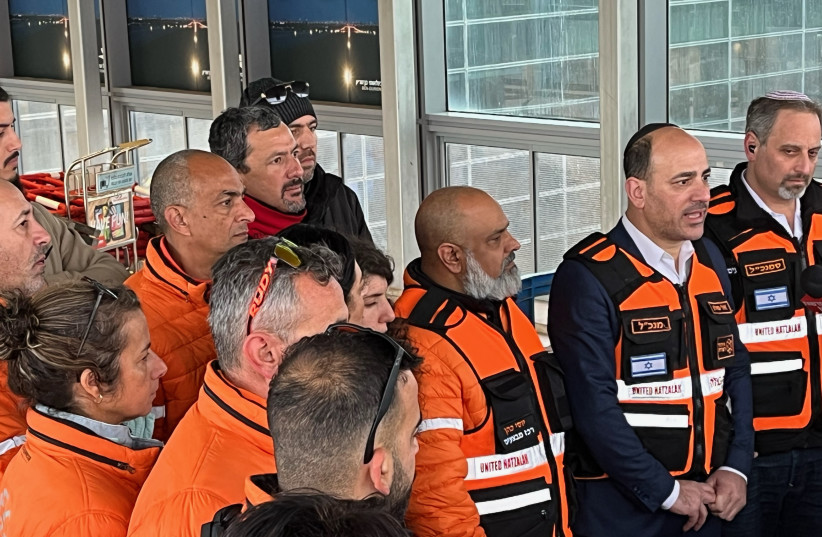United Hatzalah joins ‘Israel’s mission of saving lives’ in Turkey

An emergency medical delegation from Israel's United Hatzalah is being sent to the epicenter of the earthquake disaster in Turkey.
GAZIANTEP - Dov Maisel barely felt the tremors in his home in Ramle on Monday morning.
His wife told him there was an earthquake and he told her to go back to sleep.
The news soon broke — a magnitude 7.7 earthquake had shaken central Turkey and northern Syria, leaving thousands dead and injured.
Maisel, VP Operations for United Hatzalah in Israel, may have missed the initial tremors, but the aftershocks of the immense tragedy that had befallen the Anatolia and the Levant were not lost on him or his non-profit volunteer emergency medical service.
After long hours of mission preparation on Monday, a Maisel, CEO Eli Pollack assembled at Ben Gurion Airport on Tuesday morning to send off an emergency medical delegation to the epicentre of the disaster in Turkey.
A team of 25 had been selected from the 400 United Hatzalah members who had immediately volunteered. The team consists of medics, doctors, search and rescue personnel, and psychotrauma specialists. Some, like Maisel have joined multiple missions abroad — he had volunteered in Haiti and Nepal, and most recently in Moldova, providing aid to Ukrainian refugees. Others, like mission commander Yossi Cohen of Kfar Saba, would be traveling abroad for the first time with United Hatzalah.
Israeli rescuer in Turkey: Volunteering can be addictive
Maisel said many were “double vests,” people who volunteered for multiple additional organizations, such as Magen David Adam.
“It’s a certain type of people,” he explained. Volunteering could be “addictive.”
A team of 25 was “ a relatively big team for go team,” said Maisel. Usually, the initial exploratory emergency teams were 5-6 people.
“Based on the conditions on the ground and the local resources available it was decided that a larger group was needed,” he said.
Once on the ground, the team will determine what is needed for a larger attachment, such as more doctors or more search and rescue squads.
In foreboding weather, a chill rain, the team gathered, making last-minute preparations. Sleeping bags, combat rations, drones and more equipment were unloaded from trucks. The volunteers donned their orange jackets and emergency vests.
Maisel warned the team before departure that it would not be able easy, but that they would be saving lives under the flag of Israel.
“We’ll be fulfilling Israel’s mission of saving lives abroad.”
Cohen said in a briefing before take off that “we can’t save everyone, but everyone saved is a success. Even if it’s helping a small boy who is lost in the street without his parents, that’s his success.”
Talks of up to 40,000 casulaties
Initial briefings by Cohen warned that conditions were unclear on the ground and that they didn’t fully know what operating constraints would be.
There was talk of upwards of 40,000 casualties, killed and injured counted together.
The safety of the volunteers was also a concern, be it the elements or the unstable structures — or terrorism.
The mission’s officers were concerned about Islamic State operatives and untethered Syrian soldiers roaming the area after the quake.
Cohen implored the team to keep themselves safe.
“Our main mission is to save lives, but protect yourselves.” He said.
They wouldn’t be able to help anyone if injured themselves. Everyone would operate in squads of three, and no one would go off on their own.
As the plane landed in Gaziantep, Maisel said they were going to be operating as soon as they stepped onto the tarmac, and figuring out where they were most needed.
“We are going to meet the uncertainty of the disaster,” he said.
The unexpected was to be expected — such as the team of Israelis landing next to an Iranian military plane.
While United Hatzalah wouldn’t be working with the Iranian military, they would be in coordination with the IDF’s Homefront Command relief team, which had set off hours earlier. An IsraAID core investigation team has also joined the United Hatzalah flight, and they would accompany them to the first camp, performing initial assessments for long-term aid needs.
At the airport, the Israeli volunteers loaded up their equipment onto a truck and prepared to set out into the Anatolian night.
Jerusalem Post Store
`; document.getElementById("linkPremium").innerHTML = cont; var divWithLink = document.getElementById("premium-link"); if (divWithLink !== null && divWithLink !== 'undefined') { divWithLink.style.border = "solid 1px #cb0f3e"; divWithLink.style.textAlign = "center"; divWithLink.style.marginBottom = "15px"; divWithLink.style.marginTop = "15px"; divWithLink.style.width = "100%"; divWithLink.style.backgroundColor = "#122952"; divWithLink.style.color = "#ffffff"; divWithLink.style.lineHeight = "1.5"; } } (function (v, i) { });

